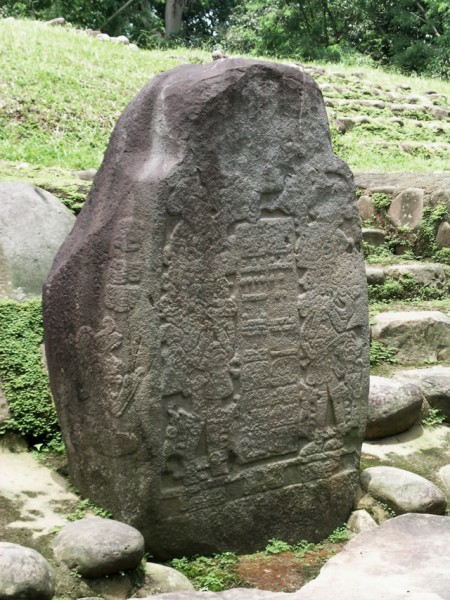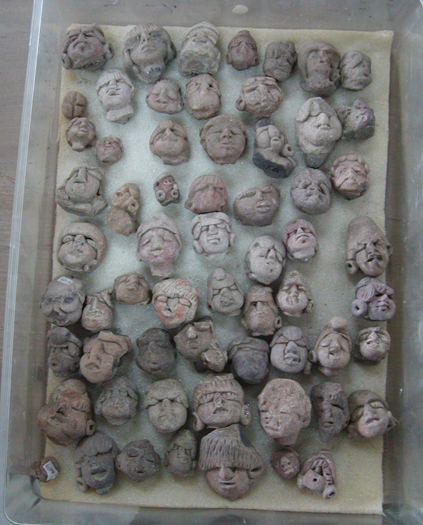The Preclassic period of Mesoamerican history (1500 BC – 200 AD) has left fascinating historical clues about what life was like in the form of monumental sculptures hewn out of boulders commonly called “pot bellies” (barrigones in Spanish) due to their distinctive shape. Yet, despite the fact that writing emerged during this time, the pot bellies lack any sort of description of historical context. Who built them and why?
Professor Julia Guernsey from UT’s Department of Art and Art History has recently published a book in which she combines the methodology of history, art history, and archaeology to offer a new look into this mysterious period at the beginning of recorded history in the Americas.
Guests
 Julia GuernseyProfessor in the Department of Art and Art History at the University of Texas at Austin
Julia GuernseyProfessor in the Department of Art and Art History at the University of Texas at Austin
Hosts
 Joan NeubergerProfessor of History, University of Texas at Austin
Joan NeubergerProfessor of History, University of Texas at Austin
Let’s start with the last two words of your title: “Preclassic Mesoamerica.” Where and when are we talking about?
Preclassic starts about 1500 – 1200 BC and goes through about 200 AD, and my book focuses on about 900 BC to 100 AD.
And Mesoamerica?
Mesoamerica is … the book focuses on Guatemala and Mexico, but I touch a little bit on Honduras, El Salvador–that part of the world.
You look at some big stone monumental sculptures, and that’s what we associate with this region before Europeans arrived. What kind of sculptures do you study?
Well, I’ve studied the gambit. My first work focused on the beautifully carved monuments that we associate with rulership, and are the first things that jump to peoples’ minds when they think about this region and this time period. But this book that we’re talking about today actually focused on monuments that are big blocky boulders, and they’re very different, and they’re very intriguing because of that.
Can you describe them?

Sure. They’re made from massive boulders, often times several tons in weight, although we also get little itty bitty ones, so there’s a range in variation, but the most famous ones are huge. They’re called “pot bellies” for obvious reasons, if one looks at one it’s fairly clear why that name was given to it. They always have a series of features, closed eyelids, puffy kind of jowly features and often times pursed lips so they’re quite intriguing.
And they all have these same–
–they’re all similar, yes. And there are over 130 of them known, so there was something going on that I found interesting.
And where were they found?
Well, that’s a good question. A lot of them lack primary context, so only a handful—only six or seven to ten have primary archaeological context.
When you say that, you mean we don’t know if they were outdoors or in a house…
Outdoors—these were outdoors in plaza spaces, usually at the base of mounds or in the wide open plazas, so very much part of the public performative space, these ceremonial centers. But, a couple were found in households. So, there’s no easy answer.
What do you think they were about? What was their function?
In the book I argue that the primary theme was ancestors, that they were about establishing lineage histories, the kind of puffy features are about–they’re dead, they’re kind of bloated dead people on one level. But it’s not sad, they’re actually these kinds of revered ancestors. I think they were elite, that they were crafted by elites and probably rulers of various sites, and that this is all about elite lineages, or crafting community between elites with these somewhat anonymous ancestors.
So, the kind of abstract idea of the ancestors. And this myth seems to have been shared over this very large space.
Exactly, and I think this is part of an imagined community.
What do you mean by that?
What I mean is that I don’t think they were necessarily sharing these ancestor figures by blood or kin relationship, but that the rulers at this time were crafting these constructed identities or lineages to set themselves apart from other people.
Do you have any way of knowing how they were used, or…
A couple of them are associated with tombs, which is part of the reasoning behind marking them as ancestors and deceased figures and they appear to mark tombs in later periods as if they were remembering and memorializing the individuals interred in that tomb. Other than that, we don’t have a lot of information about how they were venerated. Some of them were set up–just a couple–with an altar in front of them so, potentially for some sort of ritual purpose, but there’s no really good evidence.

How do you know what you know? We historians in the History Department almost exclusively work with texts. Do you base your analysis on the visual property of the big stones, or on text documents that provide context?
That’s a great question. My methods, I think, are diverse. These were conceived and carved and erected at a time when we do get some of the earliest writing in Mesoamerica—hieroglyphic inscriptions. But they are not inscribed. So that became an interesting issue to play with, too—their surfaces are clearly not perceived as appropriate for text. We have to, then, understand them as that; not to bemoan the lack of text, we have to try to understand them in the way they were meant to be understood.
Were some of the objects you studied in your first book inscribed?
Yes, but we often can’t read it!
Because it’s worn out?
Because it’s the early writing that we’re talking about in this period—late Preclassic, around late 300s BC to 200 AD, it’s not well understood. It’s not well deciphered yet. We can pick out glyphs that we recognize, but the pot bellies didn’t have these glyphs. So, I rely very heavily on the archaeological record, I spend a lot of time looking through that material–
What’s in that material?
Well, what I was looking at is that the pot bellies emerge about 300 BC, and they seem to be closely related to the advent of state formation. So, what I was looking at in the archaeological record on the excavation that I was working with, that I do not direct but that I worked on as the iconographer, I was interested in what were the social changes that brought about the advent of this new sculptural tradition. I wanted to get at what were the kinds of sculptural forms before it and how did those shift one we get centralized political structures, increased economic centralization and those sorts of things.
So you see the pot bellies emerge around 300 BC, and we know that’s a time when states were beginning to form. Do you see direct connections, or do you extrapolate that they were connected? I’m sure you wish you had documents!
I’ve convinced myself that I see direct connections. I think it’s convincing if you look at all the evidence. For one thing, one of the things that predates the potbellies is that we have ceramic hand held figurenes-abundant, thousands of them from the middle Preclassic period, the period before the potbellies with the same features. Then there’s a complete cessation of that, and those are the hallmark of domestic ritual, private ritual, and they were being utilized by everyone in the whole social spectrum from commoners to elites.
Those abruptly decline and then we get the pot bellies that draw from the same suite of features, but they’re appropriated by rulers, and we get the stuff from the public monumental centers and they’re strictly controlled. So, the evidence is there, you just kind of have to look for it—these kind of larger trends and the changes.
You associate these with some kind of state usage and some kind of effort to differentiate classes. Could you talk about that a little bit?
Sure. One of the things about the pot bellies is that they’re found at sites of all socioeconomic ranks. We have a pretty good sense of what is a primary center, secondary, tertiary–sometimes up to a five tier settlement system in these regions.
I’m not sure I understand what that means.
Well, there would be a center site that housed the paramount authority in the region, and then subsidiary sites that went down the ranks. And the pot bellies show up at sites from the first tier, second tier, third tier all the way on down, so that also became interesting that they clearly weren’t the stuff of only the primary, the paramount authority in the region. Whereas the stelae with the hieroglyphs and these more elegant, mythologically charged themes, those are only found at the primary sites. So it was interesting to try to understand what the pot bellies did differently and what they can tell us about these relationships between elites of varying ranks. So the pot bellies are doing something that other sculpture is not necessarily doing.

And you associate it with ancestor veneration, and what else?
I think it’s ancestor veneration, but it’s also this performance of ancestry. A lot of them have these pursed lips that are very distinctive. When I went back and looked at the ceramic figurenes that predate them by hundreds of years and are no longer being made when the pot bellies are being made, many of the figurenes have those same pursed lips. They’re pursed because they’re actually whistles, so there was an acoustic aspect to this. I think the pursed lips on the pot bellies are sort of a relic of this. The acoustic properties of these are ocarinas that have these puffy faced features, and that was—there’s great evidence from later periods, ethnohistorically and even in the modern ethnographic — in the present groups of Mayas and other groups in Mesoamerica of calling out the ancestors with sound, or articulating with a sign of your vital life essence. Your living breath can be performed through the act of whistling. So I think in other words they’re portraying these ancestors as vital beings.
And they’re speaking to them? Connected to them?
I think so, yeah. And there are other sculptures where we have these animated expressions. Their lips are parted. We also know that the act of speech and articulating was associated with the ruler — even the term for that in some groups in Mesoamerica relating to utterance and the ability to make speech is what made one a ruler.
Do you think of yourself as a historian?
I had a talk with some undergraduates last week, and I thought we would be ahead in our field and call ourselves historians of art, rather than art historians, because I do think that we’re using the methods of history, that’s kind of our primary vehicle, but in places where we don’t have texts we’re using the objects as text. So methodologically, I was really looking for sources that did that, trying to find people who talked about the way objects changed the way we move through, we can understand them as guiding us-comparable to the way a text might guide us as well. So, I do think of myself as somewhere betwixt and between art history, history and archaeology. I’m probably a very archaeological art historian, but I don’t know a single archaeologist who would ever call me an archaeologist! To them I’m an art historian. It’s a methodologically diverse field!